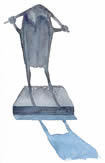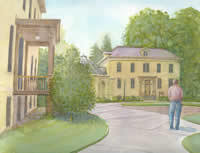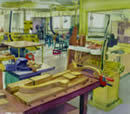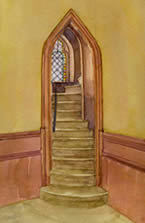
Jeremiah, an obscure sculpture located just south of the main door to Grace Hall, with his iron yoke and face of sorrow symbolizes our heavy burdens. And yet hope prevails.
Did Waldemar Otto realize how many thousand of students, faculty and staff would, over the years, walk past and around this statue?
I first saw this statue 30 years ago, and the intrigue still holds.— Sparky Tavis,
former director of Lay Ministers, Master of Divinity program
Spare but elegant, the chapel of Alumni Hall is a witness to me of continuity, a bridge from the Notre Dame of my student days as an Alumni Hall Dawg to my current tenure as a professor. Much has changed here during my 34 years of affiliation with Our Lady’s University, but that chapel was packed with students every Sunday night three decades ago, and it is packed with students every Sunday night these days—and on feast days as well.
So there was a shiver up my spine when I attended Mass there on the first Sunday of Advent 2007 and joined many others in the aisles because the pews were already crowded with students singing heartily, praying confidently and listening carefully as Father Bill Lies, CSC, delivered one of his finely crafted homilies. A long-displaced Southerner, I still grumble at the snow and ice complicating my path on frigid campus walks taken between December and April. But hardness of heart melted away as I stepped into the warmth of our dorm, our chapel, our community praising the Lord and anticipating His arrival. (One happy change is the diversified composition of “our community,” signaled by greater presence of African American, Hispanic American and non-American students. Not to mention . . . women!)
It was difficult not to think, while observing the Dawgs baying as one in worship, that this is the best answer to the prophets of doom who bemoan the loss of Catholic identity, the indifference of the younger generation, the supposed secularization of Catholic higher education. And I was relieved to suspend, at least for that evening, the cynicism I have developed about the commercialization and über-marketing of the Notre Dame “tradition,” “faith” and “mystique.”
That night I felt much the way I felt when I first set foot in that chapel, eager to belong to something more noble than myself, more challenging than the local parish and more concrete than “Catholicism” in the abstract. I felt connected, both vertically and horizontally. On the way home, I was not annoyed by the (still ridiculous) ice and snow in my path.
— R. Scott Appleby ’78, professor of history
director, Joan B. Kroc Institutefor International Peace Studies
My friends will tell you that playing linebacker on the Cavanaugh interhall flag football team is of utmost importance to me and rivals my role as student body president as my most memorable extracurricular activity. We made it to the championship my freshman year but were served our first loss of the season after a tough game. This year, we had a 3-3 regular season and were seeded a disappointing sixth in the playoffs. Over the next few weeks, we perfected our plays and moved through the bracket to again arrive at the championship game. After a defensive lockdown and a series of successful drives, the scoreboard read Cavanaugh 14, Welsh Family 0. For us, the celebration had the magnitude of a Super Bowl victory. We gathered in the end zone for a team picture and received the Championship Trophy before our photo shoot. The south end zone of Notre Dame Stadium, where I held the trophy and celebrated with my team, is without a doubt my favorite spot on campus.
— Liz Brown ’08, student body president
The lamppost marked CR-42 near LaFortune and Crowley Hall of Music has a beautiful view of the Main Building and Basilica. It is in many respects the halfway spot between Pasquerilla East, where my girlfriend resided while on campus, and Fisher, where I have lived all four years. I would always walk her back to her dorm after an evening together, but during the winters we agreed to part at CR-42. I was also in Marine Option ROTC, which meant waking up the next morning at 0530. Some nights when we would study at the Knights of Columbus building she realized that I would have to trek most of campus, leading her to demand we part at CR-42. Those walks allowed us to talk about a plethora of topics and certainly helped develop our relationship in a wholesome way. CR-42 will always remind me of the years that my girlfriend and I spent together and those long walks we would take back to her dorm.
— James Carlson ’08
A less well-known spot I love is the Chapel of Saint Andrew in Corby Hall, where the Holy Cross priests and brothers pray the daily office and celebrate Mass. It has been remodeled many times but still has the original stained glass, evidence of its long history on campus. It is immaculately kept up by Brother Ed Luther, CSC, always with fresh flowers and the colors of the liturgical season. In it is Father Tony Lauck’s beautiful bronze relief of Our Lady of Sorrows and a photograph of Blessed Brother Andre Bessette, CSC. On a hectic day, in the midst of a busy campus, it is a quiet place to pause for a few moments and find peace, consolation and guidance.
— Father John Jenkins, CSC, ’76, ’78M.A.,
University president
Some may not know Bond Hall by name, some may only know it for the expanse of steps where the band offers its concert before stepping off to the stadium, but for me it offers one the best places to think, and when I go there I am usually thinking about Notre Dame. Bond Hall houses our School of Architecture. Just inside its main doors is a wonderful, intimate library that for me is an oasis—although I expect for the students it may be a place of academic torture! I have worked here for some 24 years; 17 in the Main Building. It too is wonderful, but it is a place of business commotion, of reaction. So when I need to think—really think—I take off and over to Bond I go, sometimes for an hour, sometimes for a day, but no matter the duration it is time well spent.
— Dan Reagan ’76,
associate vice president of University Relations for Principal Gifts
Saint Joseph’s and Saint Mary’s lakes hold lots of memories for me. I grew up in South Bend. The first time I remember coming to campus was a field trip in fourth grade, studying Indiana history.
When I was a freshman, one of my best friends from high school also attended Notre Dame. Derrick and I were both planning to major in engineering and were required to take chemistry, taught by Dr. Emil T. Hofman. Emil gave grueling quizzes every Friday that students called “Emils.” Derrick and I walked around the lakes every Thursday night as a study break. We complained about how hard life was because we had to take Emils and could hear the distant shouts from dorm windows: “EMIL, EMIL.” The lakes became the place where I walked with friends and shared dreams, visions, fears and concerns. A couple of days before graduation, I remember walking around the lake with my friends Alena and Kathy. We were sure it would be our last time to reflect on our short lives and solve the problems of the world.
A couple of years ago, Kathy came back for her nephew’s graduation. She brought her children all the way from California so they could see the campus. We went back to our dorm and took them to the lakes. We told them stories of our four-year journey while they chased ducks and fat geese as my toddlers had done. I remember the fascination my preschoolers had feeding popcorn to fish and watching them swim to the surface. Now with one kid in high school and one in college, I find myself having heart-to-heart talks with them while we follow the same paths I walked almost 30 years ago.
When it’s warm, my husband and I sit by the lake and reflect on our lives. When I dream of our future, I imagine us bringing our grandchildren to build memories by the lakes.
— Jackie Rucker ’83
director of Community Relations

I was enchanted the first time I saw it, the little street of warm brick buildings on a road leading down to the lake. It was 1975, and I was a newly hired assistant professor, newly fledged from graduate school, and feeling alien in the nearly all-male world in which I had been deposited. Even the buildings felt male. My office was in the nether regions of a library with strict vertical lines and a host of men soaring up its muraled façade; I walked to my classes in O’Shaughnessy down long halls of hard tile and glazed brick walls. But one afternoon I stepped out the back door of the Main Building and found myself in a European village. There in the sunshine stood Brownson Hall, a little courtyard with wrought iron gates, the old Earth Sciences Building, low and humble, with flowers spilling from pots on the steps. The Presbytery was off to the side, Saint Michael’s Laundry down the slope, and glimpses of the lake shone through the trees. It seemed a domestic space, almost feminine, and suddenly I didn’t feel as alien anymore.
It is changed now, of course. The laundry burned down; the road was widened; the buildings were reassigned. The inevitable demands of parking and progress shouldered aside some of the charm, but over the years, I have gone there when I can, approaching the Main Building from that direction, walking down past the Grotto to take my lunch to the lake.
I taught one semester in the old Earth Sciences building. The classroom in which the students and I broke open poems and stories was filled with geological specimens in cupboards and displays that lined the walls. My memory calls up fossils, amethysts and other crystals. I felt snug and joyous there as the students and I examined the written word in the presence of artifacts that nature had written with water and fire. For a teaching poet, I thought, no setting could be finer.
— Sonia Gernes
professor emerita of English
My favorite spot on campus is the stage of Washington Hall, looking out over the audience. I taught in Washington Hall my first year at Notre Dame, 1984–85, when classes were still held there. To teach a theatre class in the campus’s only theatre was a treat: it made explanations of “stage left,” “stage right,” “down stage” and “up stage” easy to explain because I could show the students exactly what I meant. At the time, I knew little of the history of the University, but, over the years I came to appreciate the thousands of persons who preceded me on that stage, from its dedication in June 1882 to the present day. For much of its life, Washington Hall has been truly at “the crossroads of the University,” as Father Ted has described it for the book on Washington Hall I am writing, with the stage itself at the center of that crossroads.
— Mark Pilkinton, professor,
Department of Film, Television and Theatre
As both a graduate of the School of Architecture and a professor, I have a myriad of memories that tug at my nostalgia, but at this point in my career (not being able to separate what interests me from who I am) I am always attracted to that wonderful space between the apse of the Basilica and Brownson Hall, the most “urban” space on campus that puts me in mind of my studies and practice in Europe. I wish we had more spaces like it.
— David Mayernik ’83, associate professor,
School of Architecture
I can usually be found doing work in Waddick’s, the coffee shop in O’Shaughnessy Hall, and some friends call it my office. But it’s not just about the great location, fresh coffee or amazing employees. I love when professors and friends wave through the glass windows along the main hallway. Such a little gesture is an everyday reminder of the welcoming and relaxed academic community we have here. I love this atmosphere; it’s what makes Waddick’s feel like home.
— Keri Mikuska ’08
I came to Notre Dame as a freshman in 1982, enrolled as a Communication and Theatre major and began a long term relationship with the Notre Dame experience in a place called The Loft: a converted attic in O’Shaughnessy Hall turned into a makeshift departmental office/TV studio/movie cinema/film editing fortress/get-away-from-the-rest-of-campus hangout.
Go to O’Shaughnessy. Try to find it on your own. You can’t. It’s one of those other worlds in The Chronicles of Narnia. The ceiling is the underside of the roof. No windows, but you can feel the walls and tell whether the sun is shining. Cool crevices. Leaky tiles. Erratic AC. Occasional rodents.
In 1988 I returned as a faculty member to teach in The Loft. My office was there; an awful place to make a film and a great place to make a friend. Metal poles in the middle of the room cast fat shadows on the movie screen. The air ducts roar constantly, the hot water pipes clang and students lounge on castoff 1960s furniture. They sift through closeups and sound bites. Pizza boxes pile up; 10 p.m. turns into 10 a.m. and they’re still there.
Every film major prior to 2004 can tell you a story about nights spent in The Loft. We had a full-sized mattress that was used more as a bed than as a film prop (its intended use). I edited my student films there, I edited my students’ student films there, and I brought my kids there to play Ping-Pong. I’ve met more people in The Loft than anywhere else in my life. It’s cozy, it’s decrepit, it’s uniquely Notre Dame.
— Ted Mandell ’86, associate professional specialist,
Department of Film, Television and Theatre

My favorite spot is the wood shop in the basement of Bond Hall. After each Concert on the Steps on game day, I go in and look at all the wonderful projects that the architecture students are working on and admire the cool woodworking tools in the window. It’s a brief respite before a busy game day.
— Ken Dye,
director of bands and professor of music
Sorin Hall opened for student use in January 1889 with 50 individual student rooms. Additional rooms were added in 1897, but the most distinctive characteristic of the structure has remained the porch.
The backdrop to such events as the Sorin Talent Show, the porch has many stories to tell. One involves the wooden sign hung on the cross beam over the porch in 1969, in the midst of protests against the Vietnam War, when a group of residents decided to change the hall’s name to “Sorin College.” Sometime in the 1980s it was discovered that the sign had disappeared. No one knew what had happened, but my instincts told me that another male dorm had stolen it as a prank. I suggested we leave the space empty, even though it would have been simple to make a new sign, and get the other rectors involved. It was unlikely that whoever had perpetrated the prank would be able to keep quiet about it. About two weeks later, the sign reappeared. One of the rectors had identified a team of thieves from his dorm, and after he alerted them to the potential of severe penalties, they repeated their operation in reverse.
The porch has always been a wonderful place to hang out, especially in good weather. When I stepped down as president, a new set of swings was erected in my honor. Particularly in the summertime, I have enjoyed sitting on the porch watching the world go by. You can regularly hear the chatter of tour guides and the questions and comments from the steady stream of first-time visitors.
During the football season, the Sorin porch is always full. Just about everyone on campus eventually walks by. Relaxing on the porch on those weekends is like sitting in Times Square when New York City celebrates the New Year.
—Father Edward A. “Monk” Malloy, CSC, ’63, ’67M.A., ’69M.A.,
president emeritus and professor of theology
Tucked behind Saint Joseph’s Lake sits the last of the University’s Stations of the Cross. Our Golgotha, a life-size bronze Jesus, hanging from the cross, flanked by a sorrowful Mary and a youthful John. The hill is hidden by the forest, so most pass by the short path to the Cross without pausing—but this sanctuary has become part of my routine three or four days a week. The Cross is about a mile and a half from my home, and late afternoons I walk there for a bit of grace and peace as my day winds down. Sometimes I bring Libby, my 3-year-old daughter, but often I come alone for a few moments of solitude. I go to the cross for silence with God. I go to watch the seasons pass and to marvel at how changes in the sunlight seem to reflect new dimensions of sorrow on the faces.
I am a convert, and I must admit that Marian devotion does not come naturally. But this Thanksgiving it snowed, and the following day the sky was clear blue. I walked from home that frigid morning to sit at the foot of the cross. I noticed that snow remained like frozen tears on Mary’s cheeks as she looked up in love and pain at her son. As the snow glistened in the sunlight streaking through the trees, I felt her there with me, waiting, understanding.
— Nicole Stelle Garnett
John Cardinal O’Hara CSC associate professor of law

I have memories beyond counting from the loft of the Basilica of the Sacred Heart: the memorial Mass on the day of the bus tragedy for our swim team; dozens of men lying prostrate for final vows; couples I’ve known for years, now walking arm-in-arm into the midst of a loving assembly.
From this place one can see amazing things: on Holy Thursday, the gaping hole in the Tabernacle, through which you can look directly at the monstrance on the Bernini altar. Like the landscape around campus, the interior of the Basilica changes with the seasons. Advent is hushed and stark, a mammoth wreath high over the sanctuary. Lenten Vespers begin deep in a late-winter darkness that yields slowly, weekly, to spring and the overwhelming burst of light and floral thanksgiving of the Easter season.
Whenever new choir members enter the loft for the first time, I make sure to take in the wonder on their faces. It is like they have made their way into the sanctum sanctorum— the “holy of holies.” These young singers will look down on the very heart of our campus. They watch and sing as the cross is carried in during Campus-Wide Stations. They behold the assembly, reaching out across the aisles, when all join in the Lord’s Prayer. They behold the seniors as we sing “Lead Kindly Light” over their final departure.
The loft has only one shortcoming. The faces of those for whom we sing cannot be seen; their backs are to us as we all face the Mysteries at the altar. But this is a beautiful sacrifice, a joyful cross to bear.
— Steve Warner ’80M.A.,
director of the Folk Choir
Along the path around Saint Joseph Lake, a dell of large oaks and various hardwoods is split by the path to the Calvary hill that ends Notre Dame’s outdoor Stations of the Cross. These woods go back in my mind to the time when I was a seminarian prospect at Old College in the spring of 1952, when Father Hesburgh had just been appointed president.
The woods are silent sentinels. The trees hardly seem bigger around these days, though I do marvel how tall they have become. As a seminarian at the old Moreau Seminary, I walked those woods to think, to be alone, to pray the psalms and to recite the rosary. We combed them for fronds to decorate a May altar.
No older trees exist anywhere close to the center of Notre Dame. Perhaps the twin copper beech trees in front of the Main Building count as ancient, and that one gnarled maple near LaFortune. But the woods I love go back to the beginning. We believe that “in the beginning” God created out of nothing, for there was nothing but God before creation began. When the world is fully loved and Christ has become all in all, we believe that we will see how God will have created from everything. “From everything” includes Calvary, and all the Calvarys of this world—all the pain, sorrow and sin, as well as all the beauty, joy and grace of all our days. The new heaven and earth will not be made from nothing, but from everything. These woods so deep and close to the heart of Notre Dame speak to me of the heart of God.
— Father Nicholas Ayo, CSC, ’56, ’62M.A.,
professor emeritus, Program of Liberal Studies
From my desk I can look out the window and have a great view of Touchdown/Three-Point Jesus. I find myself glancing out there a few times during the day and pausing to appreciate where I get to work and who I get to work with. Go Irish!
— Mike Brey, head coach, Men’s Basketball